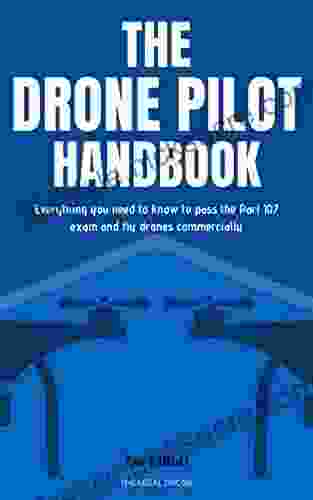Everything You Need to Know to Pass the Part 107 Exam and Fly Drones


4.5 out of 5
| Language | : | English |
| File size | : | 19512 KB |
| Screen Reader | : | Supported |
| Print length | : | 170 pages |
| Lending | : | Enabled |
Embark on an aerial adventure as you prepare to soar through the skies with drones! The Part 107 Exam is your gateway to becoming a certified drone pilot, opening up a world of possibilities. This comprehensive guide will equip you with the knowledge and skills necessary to pass the exam and unlock the thrilling realm of drone flying.
Chapter 1: Understanding the Fundamentals
Lay the foundation for your drone piloting journey by grasping the core concepts of drone operation. Learn about different types of drones, their components, and basic flight controls. Familiarize yourself with the principles of aerodynamics, stability, and maneuverability.
1.1 Types of Drones
- Fixed-wing drones: Resembling airplanes, these drones provide long-range flight and high speed.
- Multi-rotor drones: Featuring multiple propellers, these drones offer stability and maneuverability for close-range operations.
- Hybrid drones: Combining fixed-wing and multi-rotor designs, these drones provide a balance of speed and agility.
1.2 Drone Components
- Airframe: The main body of the drone, providing structure and housing for other components.
- Propellers: Rotating blades that generate thrust and enable flight.
- Motors: Power the propellers and control drone movement.
- Flight controller: The brain of the drone, managing flight parameters and ensuring stability.
1.3 Basic Flight Controls
- Throttle: Controls altitude and vertical movement.
- Yaw: Rotates the drone around its vertical axis (left/right).
- Pitch: Tilts the drone forward/backward, controlling forward/backward movement.
- Roll: Tilts the drone left/right, controlling left/right movement.
Chapter 2: Mastering Airspace Regulations
Navigating the skies responsibly requires a thorough understanding of airspace regulations. The Part 107 Exam tests your knowledge of different airspace classes, altitude restrictions, and operating requirements. Study the Federal Aviation Regulations (FARs) to ensure you fly safely and legally.
2.1 Airspace Classes
- Class G (uncontrolled): Airspace with no air traffic control, used for recreational flying.
- Class E (controlled): Airspace with limited air traffic control, requiring pilot-to-pilot communication.
- Class D (controlled): Airspace with air traffic control, requiring specific procedures for takeoff and landing.
- Class B/C (controlled): Airspace with the highest level of air traffic control, requiring authorization for entry.
2.2 Altitude Restrictions
- Maximum operating altitude for drones is 400 feet above ground level.
- Drones must maintain a safe distance from buildings, people, and other aircraft.
- Operators must be aware of Temporary Flight Restrictions (TFRs) that may limit drone operations in certain areas.
2.3 Operating Requirements
- Drones must be registered with the FAA and display a registration number.
- Pilots must maintain visual line of sight with their drones at all times.
- Drones must be flown according to manufacturer's instructions and within the operator's capabilities.
Chapter 3: Weather Conditions for Drone Flying
Weather conditions play a crucial role in drone safety. Recognize and assess different weather elements to determine whether it's safe to fly. Learn about wind speeds, precipitation, visibility, and other factors that can affect drone performance and stability.
3.1 Wind Conditions
- Avoid flying in strong winds, especially with gusts over 25 mph.
- Wind can affect drone stability, control, and battery life.
- Consider using windsocks or weather apps to gauge wind conditions.
3.2 Precipitation
- Do not fly drones in rain, snow, or other forms of precipitation.
- Moisture can damage drone components and affect performance.
- Wait for weather conditions to improve before flying.
3.3 Visibility
- Maintain visual line of sight with the drone at all times.
- Reduced visibility due to fog, smoke, or darkness can compromise safety.
- Consider using spotters or technology to enhance visibility.
3.4 Other Weather Factors
- Be aware of lightning and avoid flying during thunderstorms.
- Extreme temperatures can affect drone battery life and performance.
- Check weather forecasts before flying and postpone if conditions are unfavorable.
Chapter 4: Advanced Drone Operation Principles
Enhance your drone flying skills by mastering advanced operational principles. Understand payload capabilities, different camera types, and techniques for capturing aerial footage. Explore flight planning, mission execution, and emergency procedures to ensure safe and effective drone operations.
4.1 Payload Capabilities
- Consider the weight and dimensions of the payload when selecting a drone.
- Payloads can include cameras, sensors, or other specialized equipment.
- Payloads can affect drone flight stability and performance.
4.2 Camera Types
- Choose the right camera for your mission, considering resolution, field of view, and low-light performance.
- Types of drone cameras include still cameras, video cameras, and thermal cameras.
- Understand camera settings and techniques to optimize image and video quality.
4.3 Aerial Cinematography
- Plan flight paths and camera angles to capture visually stunning footage.
- Use techniques like panning, tilting, and zooming to add depth and interest to your shots.
- Consider lighting conditions and time of day to enhance the overall visual impact.
4.4 Flight Planning and Mission Execution
- Plan flight routes carefully, avoiding restricted airspace and potential hazards.
- Use flight planning apps or software to optimize mission efficiency.
- Follow established procedures for takeoff, landing, and emergency situations.
4.5 Emergency Procedures
- Be prepared to handle drone malfunctions, lost connection, and other emergencies.
- Practice emergency landing procedures to minimize risks.
- Carry a first-aid kit and other safety equipment in case of accidents.
Chapter 5: Preparing for the Part 107 Exam
Ace the Part 107 Exam with confidence by following effective study strategies. Review the official FAA Study Guide, practice test questions, and seek additional resources to enhance your knowledge. Develop test-taking skills and strategies to maximize your score on exam day.
5.1 FAA Study Guide
4.5 out of 5
| Language | : | English |
| File size | : | 19512 KB |
| Screen Reader | : | Supported |
| Print length | : | 170 pages |
| Lending | : | Enabled |
Do you want to contribute by writing guest posts on this blog?
Please contact us and send us a resume of previous articles that you have written.
 Fiction
Fiction Non Fiction
Non Fiction Romance
Romance Mystery
Mystery Thriller
Thriller SciFi
SciFi Fantasy
Fantasy Horror
Horror Biography
Biography Selfhelp
Selfhelp Business
Business History
History Classics
Classics Poetry
Poetry Childrens
Childrens Young Adult
Young Adult Educational
Educational Cooking
Cooking Travel
Travel Lifestyle
Lifestyle Spirituality
Spirituality Health
Health Fitness
Fitness Technology
Technology Science
Science Arts
Arts Crafts
Crafts DIY
DIY Gardening
Gardening Petcare
Petcare Bill Carter
Bill Carter Topher Donahue
Topher Donahue Jameson M Wetmore
Jameson M Wetmore Ken Chaddock
Ken Chaddock Antonio R Damasio
Antonio R Damasio Dmv Test Bank
Dmv Test Bank Amante P Marinas
Amante P Marinas Nicholeen Peck
Nicholeen Peck Theresa Y Wee M D
Theresa Y Wee M D Torey L Hayden
Torey L Hayden Eric E Bowne
Eric E Bowne Peter Hayes
Peter Hayes Tracy Lorraine
Tracy Lorraine Michaela Riva Gaaserud
Michaela Riva Gaaserud Autumn Jordon
Autumn Jordon Desi Northup
Desi Northup Dom Amore
Dom Amore Joseph Howse
Joseph Howse Anthony Horowitz
Anthony Horowitz Roman Gelperin
Roman Gelperin Don Mann
Don Mann Dima Zales
Dima Zales Sandra Luna Mccune
Sandra Luna Mccune Pico Iyer
Pico Iyer Fred Pyrczak
Fred Pyrczak Denise Ni
Denise Ni Rick Stanton
Rick Stanton Jerry D Moore
Jerry D Moore Catherine Ryan Gregory
Catherine Ryan Gregory K M Shea
K M Shea John Lukacs
John Lukacs Melody Schreiber
Melody Schreiber Joe Dante
Joe Dante Matthew L Martin
Matthew L Martin Jacob Bronowski
Jacob Bronowski Timothy Malcolm
Timothy Malcolm American Psychological Association
American Psychological Association William Rosen
William Rosen Pamela Lynn
Pamela Lynn Amby Cooper
Amby Cooper Kathleen M Stacy
Kathleen M Stacy Therese A Rando
Therese A Rando Michael Cosgrove
Michael Cosgrove Amy Brown
Amy Brown Doug Peterson
Doug Peterson Trevor Day
Trevor Day Vinod Kumar Khanna
Vinod Kumar Khanna Jennifer Margulis
Jennifer Margulis Jean Christie Ashmore
Jean Christie Ashmore Gia Giasullo
Gia Giasullo Test Masters
Test Masters Joseph Klaits
Joseph Klaits Eric Tyndall
Eric Tyndall Craig Larman
Craig Larman Andrey Ryanskiy
Andrey Ryanskiy Victoria Wood
Victoria Wood Frederick Lenz
Frederick Lenz Helena P Blavasky
Helena P Blavasky Robert A Weinberg
Robert A Weinberg June Cl Tan
June Cl Tan Suzanne Stabile
Suzanne Stabile Amie Lands
Amie Lands Jonathan Bartlett
Jonathan Bartlett Andy Couturier
Andy Couturier Julie Mosier
Julie Mosier Mac Fortner
Mac Fortner David Yoon
David Yoon Heather Macfadyen
Heather Macfadyen Elizabeth Lim
Elizabeth Lim Lady Antiva
Lady Antiva C W Lockhart
C W Lockhart Julie Barlow
Julie Barlow Thom Hartmann
Thom Hartmann Lisa Zimmer Hatch
Lisa Zimmer Hatch Josh Taylor
Josh Taylor Harley Reid
Harley Reid Stephen Goodwin
Stephen Goodwin Howard J Meditz
Howard J Meditz Shere Hite
Shere Hite Guillaume Haeringer
Guillaume Haeringer Warren B Powell
Warren B Powell Cheri Rae
Cheri Rae Claudia J Carr
Claudia J Carr Robert W D Ball
Robert W D Ball Sharon K Zumbrunn
Sharon K Zumbrunn Jack Ewing
Jack Ewing Mark W T Harvey
Mark W T Harvey Eugenia Viti
Eugenia Viti Vince Kotchian
Vince Kotchian Malba Tahan
Malba Tahan David Salsburg
David Salsburg Grant Dever
Grant Dever Jocelyn Goodwin
Jocelyn Goodwin John Maxwell Wood
John Maxwell Wood Liz Fosslien
Liz Fosslien Tom Taulli
Tom Taulli Brian Pace
Brian Pace Shaun Gallagher
Shaun Gallagher Naomi Oreskes
Naomi Oreskes Amber Smith
Amber Smith Anne Chambers
Anne Chambers Douglas Wilson
Douglas Wilson Michael Winkelman
Michael Winkelman Gal Dem
Gal Dem William Glasser M D
William Glasser M D Eric Zweig
Eric Zweig Leslie Sansone
Leslie Sansone Holly Herrick
Holly Herrick Philip Gibson
Philip Gibson John Mcpherson
John Mcpherson Sian Warriner
Sian Warriner Glenn Stout
Glenn Stout Michelle Newhart
Michelle Newhart Patricia L Papernow
Patricia L Papernow Erica T Lehrer
Erica T Lehrer Traci Gormley
Traci Gormley Theodore Sider
Theodore Sider Kumo Kagyu
Kumo Kagyu Danny Dreyer
Danny Dreyer Chris Irons
Chris Irons Joel Cotton
Joel Cotton Dan Abnett
Dan Abnett Ruth Nestvold
Ruth Nestvold David Grinspoon
David Grinspoon Pinky Mckay
Pinky Mckay Ronda Rousey
Ronda Rousey Rodney M Howard Browne
Rodney M Howard Browne Steve Greenberg
Steve Greenberg Rob Fisher
Rob Fisher Chloe Gong
Chloe Gong Paul Oliver
Paul Oliver Jan E Stets
Jan E Stets Tamora Pierce
Tamora Pierce Ryan Gray
Ryan Gray Larry K Brendtro
Larry K Brendtro Elizabeth S Gilbert
Elizabeth S Gilbert Helen E Fisher
Helen E Fisher Tim Hornbaker
Tim Hornbaker Cole Hersowitz
Cole Hersowitz Dan Schlossberg
Dan Schlossberg Mark Worden
Mark Worden Maria Youtman
Maria Youtman Brittany Clair
Brittany Clair Trent Shelton
Trent Shelton Candida Lawrence
Candida Lawrence Nikhil Bhardwaj
Nikhil Bhardwaj Iain Pardoe
Iain Pardoe Michael Reichert
Michael Reichert Muhammad Vandestra
Muhammad Vandestra Amir Alexander
Amir Alexander Hadley Wickham
Hadley Wickham Gina Chen
Gina Chen Amber Lia
Amber Lia Martin Pollizotto
Martin Pollizotto C L Simchick
C L Simchick Amy Adele Hasinoff
Amy Adele Hasinoff Jenni Hicks
Jenni Hicks Sue Monk Kidd
Sue Monk Kidd Amy Mccready
Amy Mccready Chad Ford
Chad Ford Andy Singleton
Andy Singleton Tanya Turner
Tanya Turner Ruth M Tappen
Ruth M Tappen Amelia Parker
Amelia Parker Amber O Neal Johnston
Amber O Neal Johnston Rick Deutsch
Rick Deutsch Josephine Atluri
Josephine Atluri Jonathan Law
Jonathan Law William Stillman
William Stillman Kieron Gillen
Kieron Gillen Steven C Hayes
Steven C Hayes Kyle Hunt
Kyle Hunt Christine Fanthome
Christine Fanthome Amber Zygutis
Amber Zygutis Vivian Vande Velde
Vivian Vande Velde Catherine Dees
Catherine Dees Terry Wieland
Terry Wieland Wendy Margolis
Wendy Margolis Jean Van T Hul
Jean Van T Hul Erik Qualman
Erik Qualman Jeremy J Baumberg
Jeremy J Baumberg Sheena Johnstone
Sheena Johnstone Erika Napoletano
Erika Napoletano Umer W
Umer W Zeshan Qureshi
Zeshan Qureshi Nick Kolenda
Nick Kolenda Amy Perry
Amy Perry Nicholas A Christakis
Nicholas A Christakis Erin Chack
Erin Chack Cathy Williams
Cathy Williams Carlo Buzzichelli
Carlo Buzzichelli Amy B Middleman
Amy B Middleman Donna Williams
Donna Williams James Mullaney
James Mullaney Amber Lee Sellers
Amber Lee Sellers Deborah Lipsky
Deborah Lipsky Lizabeth Hardman
Lizabeth Hardman Md Mahady Hasan
Md Mahady Hasan Sheri Van Dijk
Sheri Van Dijk Mariano Anaya
Mariano Anaya Sarah Morgan Haydock
Sarah Morgan Haydock Amiee Mueller
Amiee Mueller Gail Maccoll
Gail Maccoll Paul Wieland
Paul Wieland Tijan
Tijan Paul Dickson
Paul Dickson Kathy Spratt
Kathy Spratt Spike Dykes
Spike Dykes Adam Cort
Adam Cort Swede Burns
Swede Burns L Frank Baum
L Frank Baum Michael R Poll
Michael R Poll Tim Marshall
Tim Marshall Amy Baldwin
Amy Baldwin American Baseball Coaches Association
American Baseball Coaches Association Norman Doidge
Norman Doidge Jim Santos
Jim Santos Christopher Cousteau
Christopher Cousteau Jon Bonnell
Jon Bonnell Martin Williams
Martin Williams Paul Kockelman
Paul Kockelman Isabella Krystynek
Isabella Krystynek Cordelia K Castel
Cordelia K Castel Marco Ferrero
Marco Ferrero Anthony Haynes
Anthony Haynes Rosalind Wiseman
Rosalind Wiseman Tom Colicchio
Tom Colicchio Marisa Anne Bass
Marisa Anne Bass Diane Greer
Diane Greer Derek Thompson
Derek Thompson A Sorority Of Mothers
A Sorority Of Mothers Michael Abayomi
Michael Abayomi Mike Adamick
Mike Adamick James E Packer
James E Packer Alan I Marcus
Alan I Marcus Tom Patri
Tom Patri Stanley J Farlow
Stanley J Farlow Deborah J Rumsey
Deborah J Rumsey Joellen Patterson
Joellen Patterson Lars Andersen
Lars Andersen Susanna Heli
Susanna Heli Theresa I Soto
Theresa I Soto Amber Foster
Amber Foster Clotaire Rapaille
Clotaire Rapaille Tahlia Kirk
Tahlia Kirk John L Field
John L Field Jean Rose
Jean Rose P Aarne Vesilind
P Aarne Vesilind Gary Wiener
Gary Wiener Elise Christie
Elise Christie Kresley Cole
Kresley Cole Sonia Hartl
Sonia Hartl Jessica Hatcher Moore
Jessica Hatcher Moore Josiah Hesse
Josiah Hesse Angela Moore
Angela Moore Dana Obleman
Dana Obleman Derrick Jensen
Derrick Jensen Tavi Gevinson
Tavi Gevinson Randy Schultz
Randy Schultz John Ferrell
John Ferrell Mark Taylor
Mark Taylor Amy Camp
Amy Camp James P Kelly
James P Kelly Sean Go
Sean Go Paul Schwartz
Paul Schwartz James W Williams
James W Williams Jennifer S Kelly
Jennifer S Kelly Stanley I Greenspan
Stanley I Greenspan Thomas J Whalen
Thomas J Whalen Nathan Belofsky
Nathan Belofsky Marit Weisenberg
Marit Weisenberg Don Stradley
Don Stradley E T Bryant
E T Bryant Nikala Smith
Nikala Smith Mark Stallard
Mark Stallard Jenny Landreth
Jenny Landreth Jeanne Ryan
Jeanne Ryan Katherine Kurtz
Katherine Kurtz Andy Hunt
Andy Hunt Stephen Barr
Stephen Barr Brian Klaas
Brian Klaas David Burch
David Burch Joseph Conrad
Joseph Conrad Brian Kateman
Brian Kateman Kate Parham Kordsmeier
Kate Parham Kordsmeier Meikang Qiu
Meikang Qiu K F Breene
K F Breene Amelia Edith Huddleston Barr
Amelia Edith Huddleston Barr Victoria Richards
Victoria Richards Kenneth P Stephens
Kenneth P Stephens Kate Fox
Kate Fox Mitt Romney
Mitt Romney Cynthia Gabriel
Cynthia Gabriel Buck Tilton
Buck Tilton Temple Grandin
Temple Grandin Emma Mae Jenkins
Emma Mae Jenkins Silvia Botros
Silvia Botros Amara Charles
Amara Charles Jeffrey Steadman
Jeffrey Steadman Bethanne Kim
Bethanne Kim Sandra T Barnes
Sandra T Barnes William G Dever
William G Dever Django Paris
Django Paris Louise Bates Ames
Louise Bates Ames Janet Engle
Janet Engle Paul Kaplowitz
Paul Kaplowitz Chad Starkey
Chad Starkey Stephen Walker
Stephen Walker Gerald Corey
Gerald Corey Alan Margot
Alan Margot Laekan Zea Kemp
Laekan Zea Kemp Jack Freeman
Jack Freeman Brendan Leonard
Brendan Leonard Amy Bizzarri
Amy Bizzarri Eugene C Toy
Eugene C Toy Ana And Jack Hicks
Ana And Jack Hicks Ned Seaton
Ned Seaton Charles Thompson
Charles Thompson Ruta Nonacs
Ruta Nonacs Byron Nelson
Byron Nelson Richard Wagamese
Richard Wagamese Ignatius Donnelly
Ignatius Donnelly Robert Melillo
Robert Melillo Stephenie Meyer
Stephenie Meyer Ananda Lowe
Ananda Lowe Amrita Pande
Amrita Pande Valerie Bass
Valerie Bass The 60 Minutes Summary
The 60 Minutes Summary Dolores Kong
Dolores Kong Joan Freeman
Joan Freeman Chris Carlsson
Chris Carlsson Julie Caplin
Julie Caplin J L Weil
J L Weil Philippa Langley
Philippa LangleyK D
 Stephen M Barr
Stephen M Barr Rose Mannering
Rose Mannering Laurie A Watkins
Laurie A Watkins Jake Maddox
Jake Maddox Stephen J Collier
Stephen J Collier Camille Glenn
Camille Glenn Don Bowers
Don Bowers Dr Scott A Johnson
Dr Scott A Johnson Nisha Garg
Nisha Garg Susan White
Susan White Summer Michaud Skog
Summer Michaud Skog Edward J Denecke
Edward J Denecke Tabitha Suzuma
Tabitha Suzuma Alex Polyakov
Alex Polyakov Johan Norberg
Johan Norberg Rosanna Davison
Rosanna Davison Jack Tupp
Jack Tupp Don Orwell
Don Orwell Charles Hall
Charles Hall Robyn Davidson
Robyn Davidson Richard Cohen
Richard Cohen Anna B Doe
Anna B Doe Vicki Hearne
Vicki Hearne Kate Tietje
Kate Tietje Md Rezowan Ahmed
Md Rezowan Ahmed David Guymer
David Guymer Ned Vizzini
Ned Vizzini Paul Graham
Paul Graham Jan Marie Mueller
Jan Marie Mueller Alex Stone
Alex Stone Bridget Ericsson
Bridget Ericsson Amy Bleuel
Amy Bleuel David Elkington
David Elkington Randall E Schumacker
Randall E Schumacker William Bohan
William Bohan American Math Academy
American Math Academy Peter Worley
Peter Worley Wolf Moon
Wolf Moon Devin Olsen
Devin Olsen Candy Verney
Candy Verney Krystal Sutherland
Krystal Sutherland Saleh Alkhalifa
Saleh Alkhalifa Joseph Mcmoneagle
Joseph Mcmoneagle Victor J Stenger
Victor J Stenger Sarah Dessen
Sarah Dessen Kasie West
Kasie West Nina Freudenberger
Nina Freudenberger George Bernard Shaw
George Bernard Shaw Jason Borte
Jason Borte Sarah J Maas
Sarah J Maas Pav Bryan
Pav Bryan Kristine Kathryn Rusch
Kristine Kathryn Rusch Eric T Knight
Eric T Knight Joseph P Weir
Joseph P Weir Karen Deerwester
Karen Deerwester H Bedford Jones
H Bedford Jones Frank Nappi
Frank Nappi Dr Bob Rotella
Dr Bob Rotella Redmond O Hanlon
Redmond O Hanlon Sarah Woodbury
Sarah Woodbury Deborah Vinall Psyd Lmft
Deborah Vinall Psyd Lmft Christopher Harlan
Christopher Harlan Christopher E Larsen
Christopher E Larsen Ellie Wood
Ellie Wood Jayson Gaddis
Jayson Gaddis Joseph Wayne Smith
Joseph Wayne Smith Courtney Defeo
Courtney Defeo Amy Blakeslee
Amy Blakeslee Mark Turley
Mark Turley Rob Antoun
Rob Antoun Steven Charleston
Steven Charleston Amit Saha
Amit Saha Matthew Lombardi
Matthew Lombardi Bruce Dowbiggin
Bruce Dowbiggin Joe Nickell
Joe Nickell Tyler Simmons
Tyler Simmons Marina Robb
Marina Robb John Bingham
John Bingham Michael Parker Pearson
Michael Parker Pearson Joe E Harvey
Joe E Harvey Kezia Endsley
Kezia Endsley Jack Weatherford
Jack Weatherford Cookie O Gorman
Cookie O Gorman Amie Kaufman
Amie Kaufman David Ranney
David Ranney Sandra Bardwell
Sandra Bardwell Art Star
Art Star Neville Goddard
Neville Goddard Heidi J Larson
Heidi J Larson Jack Falla
Jack Falla Ashley Scott
Ashley Scott Patrick O Sullivan
Patrick O Sullivan Laini Taylor
Laini Taylor Henry A Zumbrun 2
Henry A Zumbrun 2 Michael Ondaatje
Michael Ondaatje Cody Monk
Cody Monk Tom Deck
Tom Deck Shanna Cunning
Shanna Cunning Jeff Martone
Jeff Martone Jason Thompson
Jason Thompson Benjamin Jelen
Benjamin Jelen J Stephen Jones
J Stephen Jones Wade Rouse
Wade Rouse Dave Hanson
Dave Hanson Joe Dan Lowry
Joe Dan Lowry Christina Kamp
Christina Kamp Reinhold Messner
Reinhold Messner Rachel Gurevich
Rachel Gurevich Kevin Stiegelmaier
Kevin Stiegelmaier Kathleen Glasgow
Kathleen Glasgow Peter Larson
Peter Larson Sterling Test Prep
Sterling Test Prep Lisa Maloney
Lisa Maloney Sarah Sumbal
Sarah Sumbal Amelia Freer
Amelia Freer John A Buehrens
John A Buehrens Robb Walsh
Robb Walsh Julie Schacht Sway
Julie Schacht Sway Rich Rousseau
Rich Rousseau Jd Mader
Jd Mader Garrett M Fitzmaurice
Garrett M Fitzmaurice Toni Tone
Toni Tone Shalabh Aggarwal
Shalabh Aggarwal Jonathon Miller Weisberger
Jonathon Miller Weisberger Amira Mikhail
Amira Mikhail Donovan Hohn
Donovan Hohn Laura Slinn
Laura Slinn Arlene Blum
Arlene Blum Jack Nisbet
Jack Nisbet Sean Gibson
Sean Gibson Jeff Gaudette
Jeff Gaudette Alexandrea Weis
Alexandrea Weis J Marin Younker
J Marin Younker Marshall Goldsmith
Marshall Goldsmith Jessica Cunsolo
Jessica Cunsolo Oscar Baechler
Oscar Baechler Clancy Cavnar
Clancy Cavnar Kris Leonard
Kris Leonard Charles J Alsheimer
Charles J Alsheimer Kathy A Zahler
Kathy A Zahler Ray Mancini
Ray Mancini John Jacobs
John Jacobs Dr Elizabeth Cherevaty Nd Rac
Dr Elizabeth Cherevaty Nd Rac Shannon O Bourne
Shannon O Bourne
Light bulbAdvertise smarter! Our strategic ad space ensures maximum exposure. Reserve your spot today!

 Jedidiah HayesAn Absolutely Gripping Psychological Thriller You Won't Be Able to Put Down
Jedidiah HayesAn Absolutely Gripping Psychological Thriller You Won't Be Able to Put Down Alan TurnerFollow ·4k
Alan TurnerFollow ·4k Dwayne MitchellFollow ·13.8k
Dwayne MitchellFollow ·13.8k Ben HayesFollow ·4.3k
Ben HayesFollow ·4.3k Brent FosterFollow ·9.3k
Brent FosterFollow ·9.3k J.D. SalingerFollow ·19.8k
J.D. SalingerFollow ·19.8k Charlie ScottFollow ·5.8k
Charlie ScottFollow ·5.8k Vince HayesFollow ·10.5k
Vince HayesFollow ·10.5k Brody PowellFollow ·19.3k
Brody PowellFollow ·19.3k

 Ira Cox
Ira CoxUnveiling the Hidden Gem: Moon, Virginia - A Washington...
Nestled within the picturesque...

 Jorge Luis Borges
Jorge Luis BorgesThe Ultimate Survivalist's Medical Guide: A Comprehensive...
In the realm of...

 Henry Green
Henry GreenDavid Douglas: Exploring the Natural History of the...
David Douglas was a...

 Eric Hayes
Eric HayesUnderstanding Citizenship in a Globalized World: A...
Citizenship is a complex and multifaceted...

 Will Ward
Will WardUnveiling Research Real Talk: Navigating the Labyrinth of...
Research, the...
4.5 out of 5
| Language | : | English |
| File size | : | 19512 KB |
| Screen Reader | : | Supported |
| Print length | : | 170 pages |
| Lending | : | Enabled |











